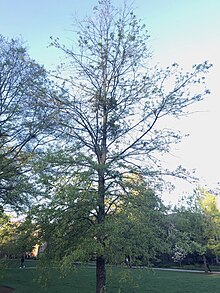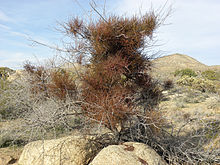| Phoradendron | |
|---|---|

| |
| Phoradendron californicum fruit | |
| Scientific classification | |
| Kingdom: | Plantae |
| Clade: | Tracheophytes |
| Clade: | Angiosperms |
| Clade: | Eudicots |
| Order: | Santalales |
| Family: | Santalaceae |
| Genus: | Phoradendron Nutt.[1][2] |
| Species | |
|
About 235-240 species; see text | |

| |
| Phoradendron distribution by state or province. | |
| Synonyms | |
| |




Phoradendron is a genus of mistletoe, native to warm temperate and tropical regions of the Americas. The center of diversity is the Amazon rainforest.[3] Phoradendron is the largest genus of mistletoe in the Americas, and possibly the largest genus of mistletoes in the world.[4] Traditionally, the genus has been placed in the family Viscaceae, but recent genetic research acknowledged by the Angiosperm Phylogeny Group shows this family to be correctly placed within a larger circumscription of the sandalwood family, Santalaceae.
They are woody hemi-parasitic shrubs with branches 10–80 cm (3.9–31.5 in) long, which grow on other trees. The foliage is dichotomously branching, with opposite pairs of leaves; these are fairly large, 2–5 cm (0.79–1.97 in) long, green and photosynthetic in some species (e.g. P. leucarpum), but minimal in some others (e.g. P. californicum). Although they are able to photosynthesize the plant relies on its host for some nutrients. The plant draws its mineral and water needs, and some of its energy needs, from the host tree using a haustorium which grows into the stems of the host.[5]
The flowers are inconspicuous and incomplete, no petals and 3-4 greenish-yellow sepals,[6] 1–3 mm (0.039–0.118 in) diameter. The fruit is a berry, white, yellow, orange, or red when mature, containing one to several seeds embedded in very sticky juice, called viscin.[4] The flowers are unisexual, and depending on the species, the plant will be monoecious or dioecious (both male and female flowers on a single plant or male and female plants with only one sex of flowers).[4] The seeds are dispersed when birds eat the fruit and remove the sticky seeds from their bills by wiping them on tree branches where they can germinate.
The foliage and berries of some species are toxic. Leafy mistletoes seldom kill but they cause stress reducing crop productions in fruits and nut trees.[7]
Phoradendron plants can be distinguished from mistletoes in other genera in Viscaceae by their inflorescences, which lack leaves and come from a single branching point or apical meristem.[4] However, it can be difficult to identify species within Phoradendron, because leaf shape and color can vary greatly even within species.[6]

- ^ a b "Genus: Phoradendron Nutt". Germplasm Resources Information Network. United States Department of Agriculture. 2010-08-25. Archived from the original on 2012-10-10. Retrieved 2011-03-08.
- ^ Cite error: The named reference
nuttwas invoked but never defined (see the help page). - ^ Coder, K. D. American mistletoe (Phoradendron serotinum var. serotinum) infection in trees. WSFNR08-25. Tree Health Series. University of Georgia. 2008.
- ^ a b c d Kujit, Job (2003). "Monograph of Phoradendron (Viscaceae)". Systematic Botany Monographs. 66: 1–643. doi:10.2307/25011253. JSTOR 25011253.
- ^ Hiller, J. B. (2010). Marvelling at mistletoe. Highlights for Children. 65(12) 40-41.
- ^ a b Kellogg, Elizabeth A. (1991). "Why Study Mistletoes?". Arnoldia. 51 (3): 11–17. doi:10.5962/p.250758. JSTOR 42954407.
- ^ Krautwurst, T. (2003) The truth about mistletoe. Mother Earth News 195 26-29.